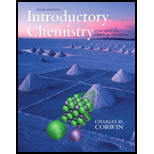
(a)
Interpretation:
Whether hydronium ion is classified as a monoatomic cation, polyatomic cation, monoatomic anion, or polyatomic anion is to be stated.
Concept introduction:
The species which is formed by losing one or more electrons from a neutral atom is known as a cation. A cation is a positively charged species.
The species which is formed by gaining one or more than one electrons by a neutral atom is known as an anion. An anion is a negatively charged species.
(b)
Interpretation:
Whether strontium ion is classified as a monoatomic cation, polyatomic cation, monoatomic anion, or polyatomic anion is to be stated.
Concept introduction:
The species which is formed by losing one or more than one electrons from a neutral atom is known as a cation. A cation is a positively charged species.
The species which is formed by gaining one or more than one electrons by a neutral atom is known as an anion. An anion is a negatively charged species.
(c)
Interpretation:
Whether sulfide ion is classified as a monoatomic cation, polyatomic cation, monoatomic anion, or polyatomic anion is to be stated.
Concept introduction:
The species which is formed by losing one or more electrons from a neutral atom is known as a cation. A cation is a positively charged species.
The species which is formed by gaining one or more than one electrons by a neutral atom is known as an anion. An anion is a negatively charged species.
(d)
Interpretation:
Whether sulfate ion is classified as a monoatomic cation, polyatomic cation, monoatomic anion, or polyatomic anion is to be stated.
Concept introduction:
The species which is formed by losing one or more electrons from a neutral atom is known as a cation. A cation is a positively charged species.
The species which is formed by gaining one or more than one electrons by a neutral atom is known as an anion. An anion is a negatively charged species.
Want to see the full answer?
Check out a sample textbook solution
Chapter 6 Solutions
Introductory Chemistry: Concepts And Critical Thinking, Books A La Carte Edition (8th Edition)
- The following diagram represents an ionic compound inwhich the red spheres represent cations and the blue spheresrepresent anions. Which of the following formulas is consistentwith the drawing? KBr, K2SO4, Ca(NO3)2, Fe2(SO4)3.Name the compound.arrow_forwardWhich of the solids making up the mixture you are given is an ionic compound?arrow_forwardCa, Cl, Na, Fe, and K. Which of these elements form cations? List their symbols with charges. Which of these elements form anions? List their symbols with charges.arrow_forward
- Differentiate between oxy-acids and binary acids?arrow_forwardA compound has the general formula X2O, with X representing an unknown element or ion and O representing oxygen. Which of the following could NOT be a name for this compound? Explain your answer. sodium oxide iron(II)oxide copper(I)oxide dinitrogen monoxide waterarrow_forwardClassify the following compounds as electrolytes or nonelectrolytes. (a) potassium chloride, KCL (b) hydrogen peroxide, H2O2 (c) methane, CH4 (d) barium nitrate, Ba(NO3)2arrow_forward
 Chemistry: Principles and ReactionsChemistryISBN:9781305079373Author:William L. Masterton, Cecile N. HurleyPublisher:Cengage Learning
Chemistry: Principles and ReactionsChemistryISBN:9781305079373Author:William L. Masterton, Cecile N. HurleyPublisher:Cengage Learning Introductory Chemistry: An Active Learning Approa...ChemistryISBN:9781305079250Author:Mark S. Cracolice, Ed PetersPublisher:Cengage Learning
Introductory Chemistry: An Active Learning Approa...ChemistryISBN:9781305079250Author:Mark S. Cracolice, Ed PetersPublisher:Cengage Learning Chemistry & Chemical ReactivityChemistryISBN:9781133949640Author:John C. Kotz, Paul M. Treichel, John Townsend, David TreichelPublisher:Cengage Learning
Chemistry & Chemical ReactivityChemistryISBN:9781133949640Author:John C. Kotz, Paul M. Treichel, John Townsend, David TreichelPublisher:Cengage Learning Chemistry & Chemical ReactivityChemistryISBN:9781337399074Author:John C. Kotz, Paul M. Treichel, John Townsend, David TreichelPublisher:Cengage Learning
Chemistry & Chemical ReactivityChemistryISBN:9781337399074Author:John C. Kotz, Paul M. Treichel, John Townsend, David TreichelPublisher:Cengage Learning General Chemistry - Standalone book (MindTap Cour...ChemistryISBN:9781305580343Author:Steven D. Gammon, Ebbing, Darrell Ebbing, Steven D., Darrell; Gammon, Darrell Ebbing; Steven D. Gammon, Darrell D.; Gammon, Ebbing; Steven D. Gammon; DarrellPublisher:Cengage Learning
General Chemistry - Standalone book (MindTap Cour...ChemistryISBN:9781305580343Author:Steven D. Gammon, Ebbing, Darrell Ebbing, Steven D., Darrell; Gammon, Darrell Ebbing; Steven D. Gammon, Darrell D.; Gammon, Ebbing; Steven D. Gammon; DarrellPublisher:Cengage Learning Chemistry: Principles and PracticeChemistryISBN:9780534420123Author:Daniel L. Reger, Scott R. Goode, David W. Ball, Edward MercerPublisher:Cengage Learning
Chemistry: Principles and PracticeChemistryISBN:9780534420123Author:Daniel L. Reger, Scott R. Goode, David W. Ball, Edward MercerPublisher:Cengage Learning





